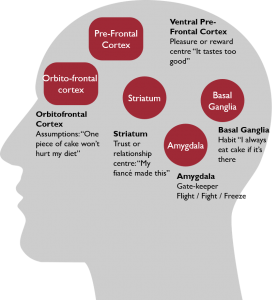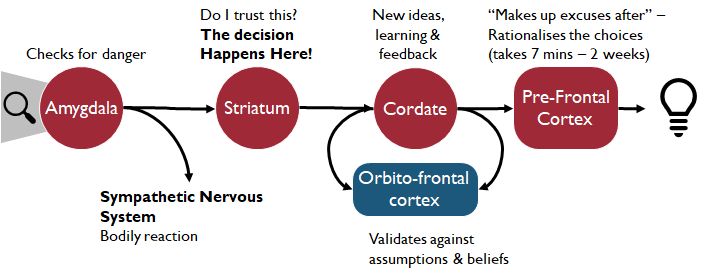Let’s first think about the brain. When considering influencing yourself or others, it’s worth looking at how the brain decides. There are several areas as shown in the diagram below.  When deciding, the Amygdala is the first area to take input, and then the striatum actually makes an emotion decision – about trust and relationship. Thus, to influence we need to make it safe and that the other person trusts us. If the person feels unsafe or untrusting, questions are a good way to re-engage the amygdala and move back towards safety. It’s only with trust, with the other person be receptive to listening for new ideas, or learning, and modify assumptions.
When deciding, the Amygdala is the first area to take input, and then the striatum actually makes an emotion decision – about trust and relationship. Thus, to influence we need to make it safe and that the other person trusts us. If the person feels unsafe or untrusting, questions are a good way to re-engage the amygdala and move back towards safety. It’s only with trust, with the other person be receptive to listening for new ideas, or learning, and modify assumptions.  There are two learnings from this:
There are two learnings from this:
- Decisions are made in the Striatum (Trust and Relationships) and not in the Pre-Frontal Cortex (Rational brain). In fact, the rational brain, justifies whatever decision AFTER the decision … so safety & trust are key to decisions
- Our body’s reward mechanisms are around dopamine and oxytocin (cuddle hormone) so influence is about increase these in the other person – praise, reward, encouragement, and making them feel good about the decisions they have made.
Improving your influencing skills
Firstly, influence isn’t the same as manipulation. We influence all the time, by our dress, our choice of words, and actions. Being more aware of them and making a conscious choice will help others become more welcoming of your ideas or reconsider theirs. Listed below are the typical ways humans influence each other – be it in a business, community or in a personal way. When looking to change you may use these techniques to help influence that change. For someone helping the change – it gives you some alternatives to your normal influencing approaches, because different approaches suit different people.
3 NLP techniques for influence